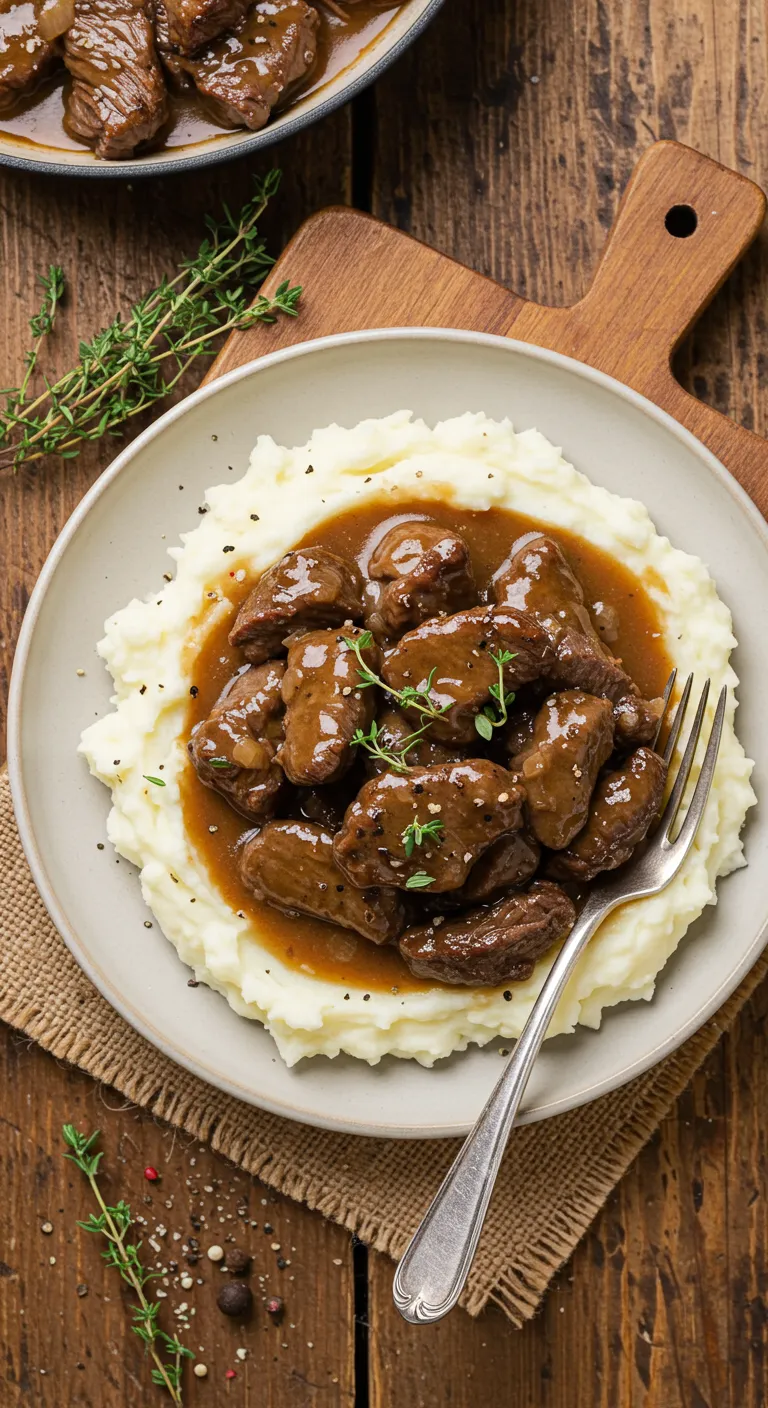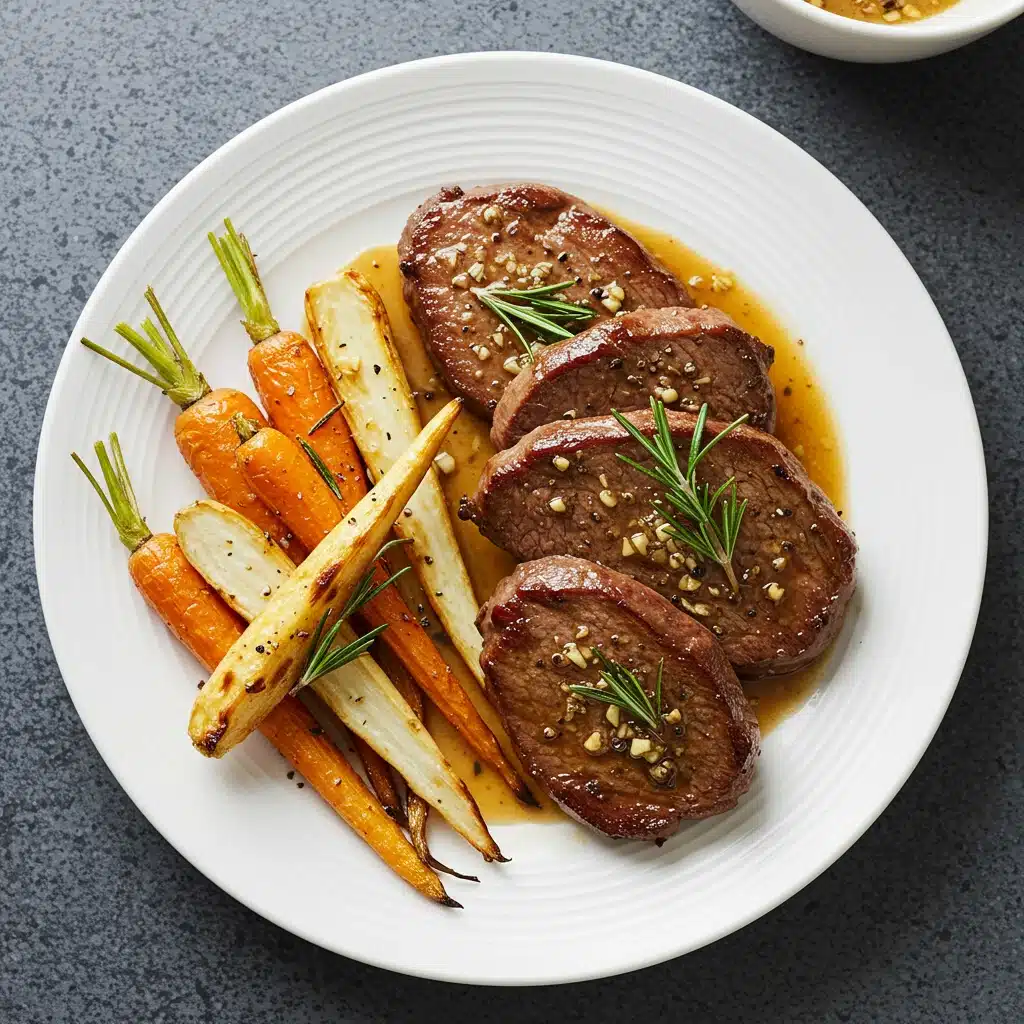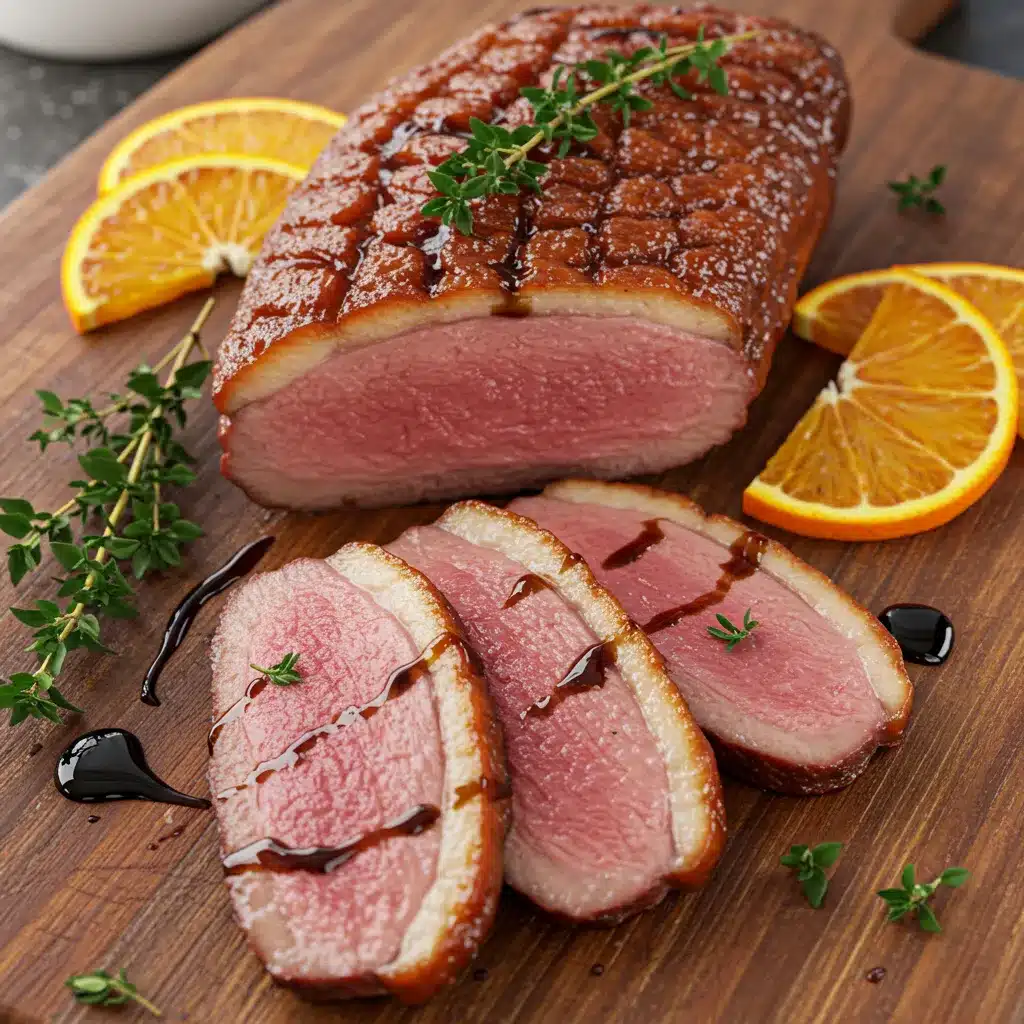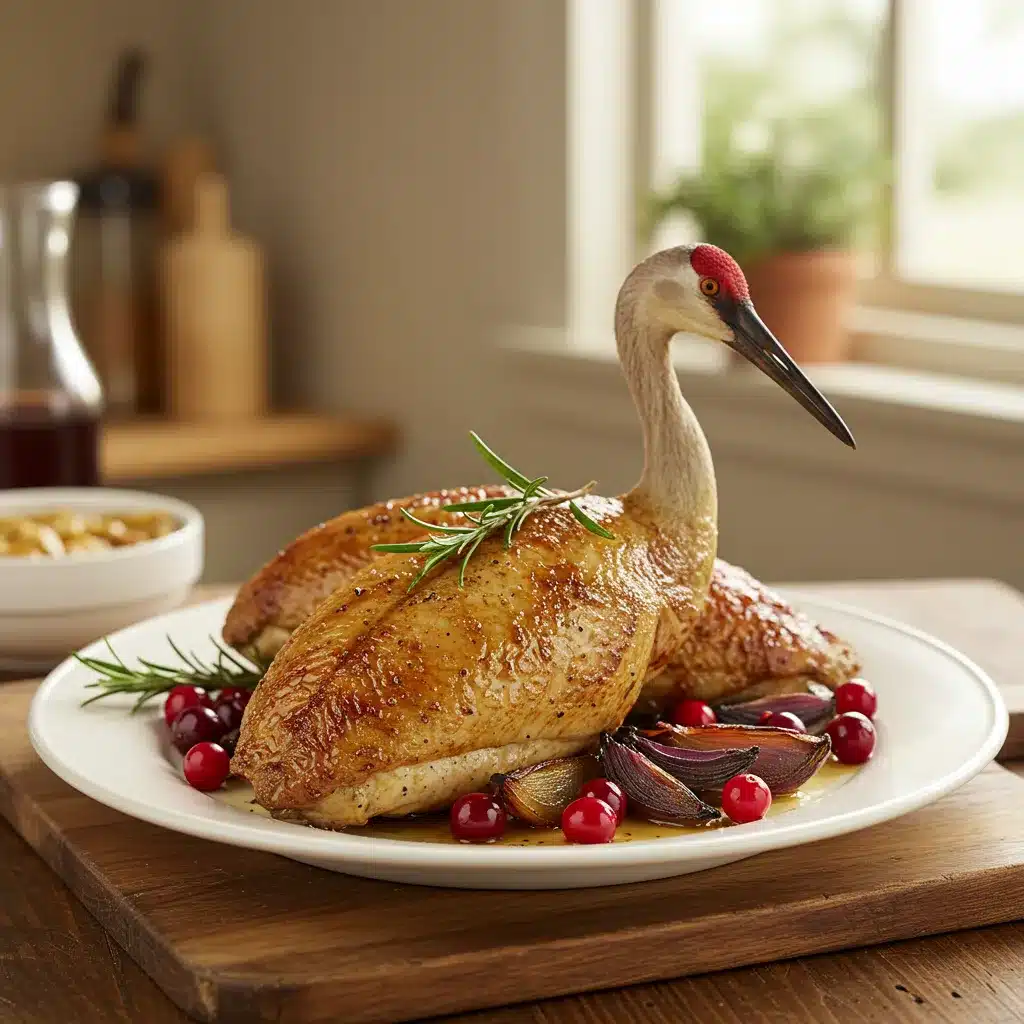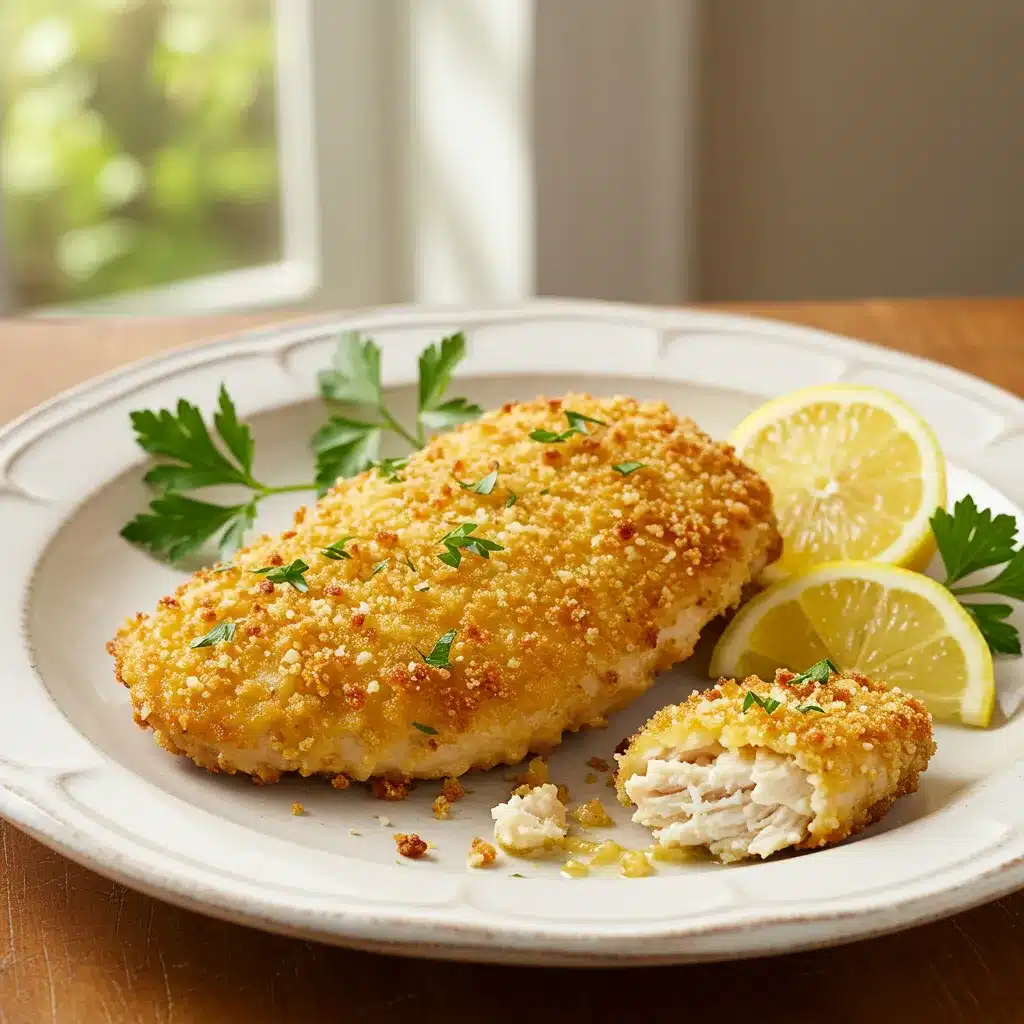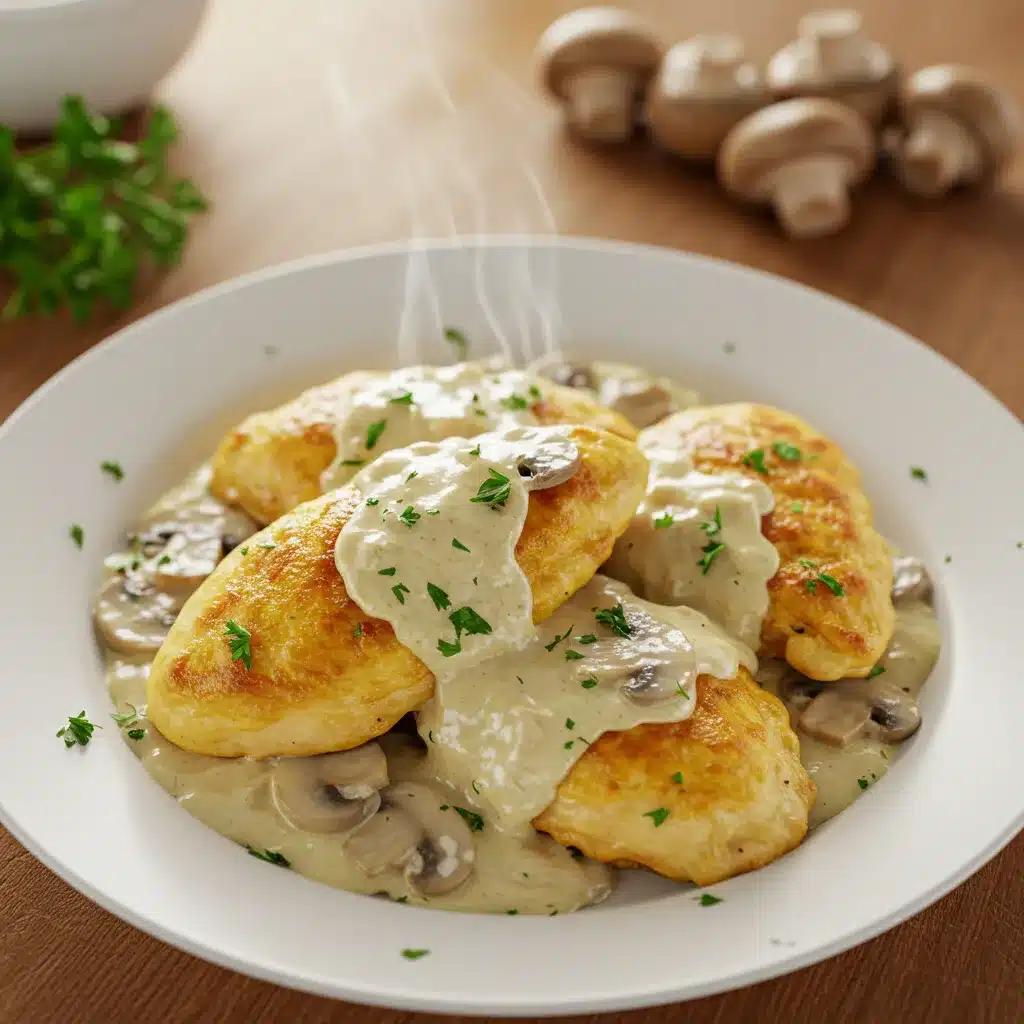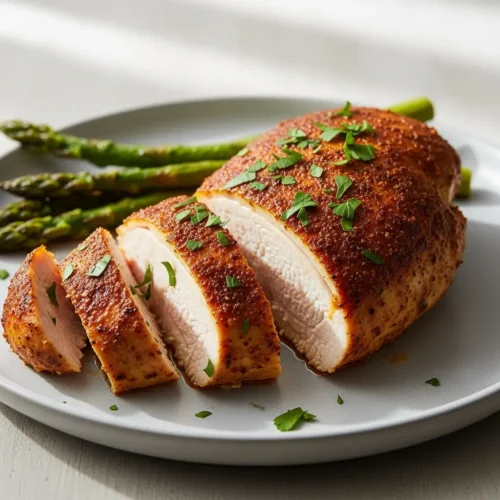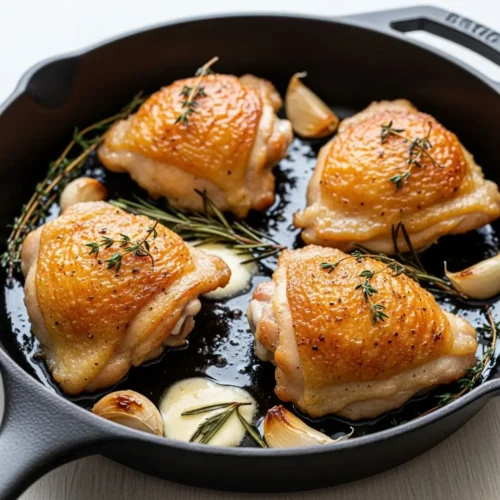Recipe Overview
Why You’ll Absolutely Love This Carnivore Chicken Recipe
Craving a meal that’s both incredibly satisfying and perfectly aligned with your carnivore lifestyle? Imagine sinking your teeth into a piece of chicken so juicy and flavorful, it melts in your mouth. This isn’t just any chicken recipe; it’s the ultimate carnivore chicken recipe, designed to deliver maximum taste with minimal ingredients.
If you’re looking for a simple carnivore diet chicken recipe that’s quick to prepare, packed with protein, and utterly delicious, you’ve come to the right place. This recipe is not only incredibly easy to follow, even for beginner cooks, but it also highlights the natural flavors of high-quality chicken. Get ready to discover your new go-to carnivore chicken dish – keep reading to find out how!
Printable Recipe Card: Your Easy Carnivore Chicken Guide!
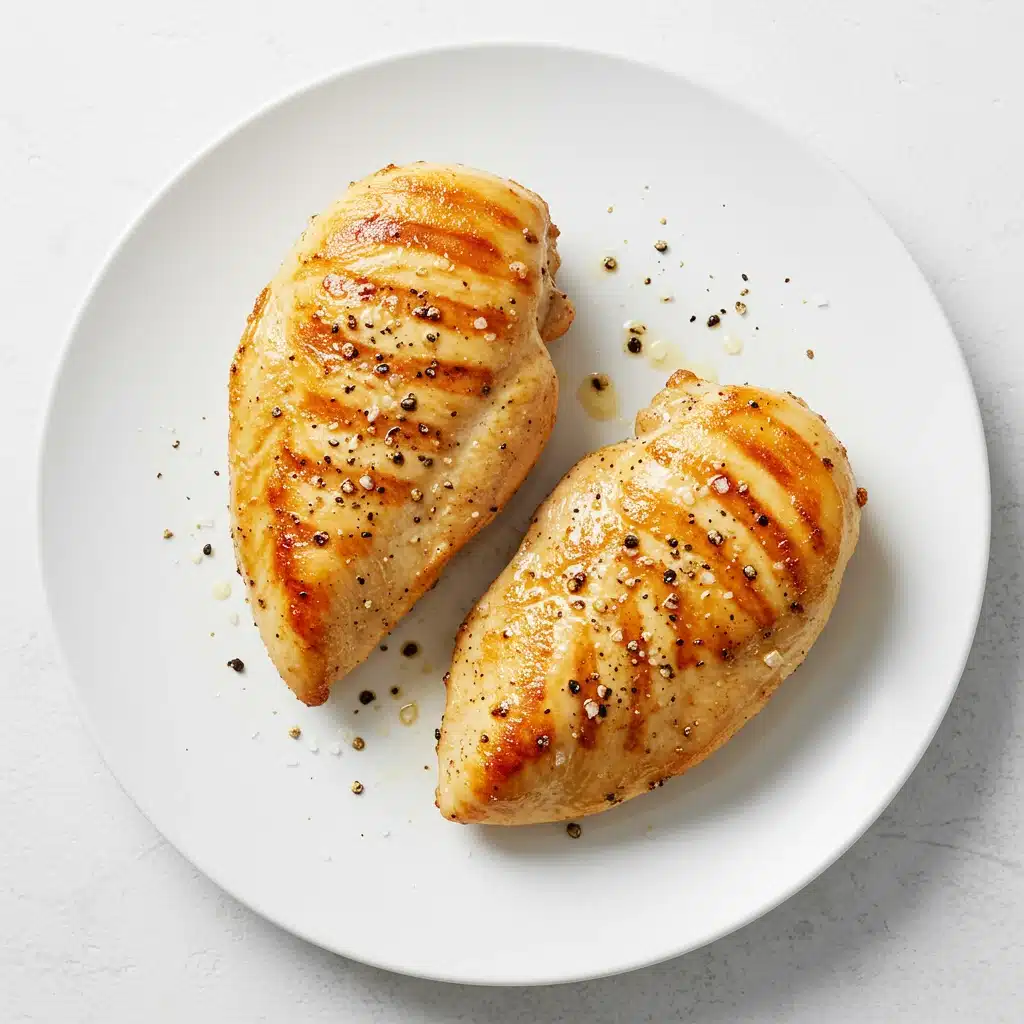
Juicy Carnivore Chicken: Simple & Delicious Recipe
Method
- Pat the chicken thighs dry with paper towels. This helps achieve a crispy skin. Season generously on all sides with sea salt and black pepper (if using).
- Heat a large skillet over medium-high heat. Add a tablespoon of rendered animal fat (like tallow or lard) to the skillet, if desired, for extra flavor and crispiness. Once the skillet is hot and the fat is melted, place the chicken thighs skin-side down in the skillet. Do not overcrowd the pan; cook in batches if necessary.
- Sear the chicken skin-side down for 6-8 minutes, or until the skin is golden brown and crispy. Flip the chicken and cook for another 8-12 minutes, or until the internal temperature reaches 165°F (74°C) and the juices run clear when pierced with a fork or knife.
- Remove the chicken from the skillet and let it rest for 5 minutes before serving. This allows the juices to redistribute, resulting in more tender and flavorful chicken. Serve immediately and enjoy your simple yet delicious carnivore chicken!
Nutrition
Notes
Tried this recipe?
Let us know how it was!What You’ll Need: Ingredients for This Carnivore Chicken Recipe
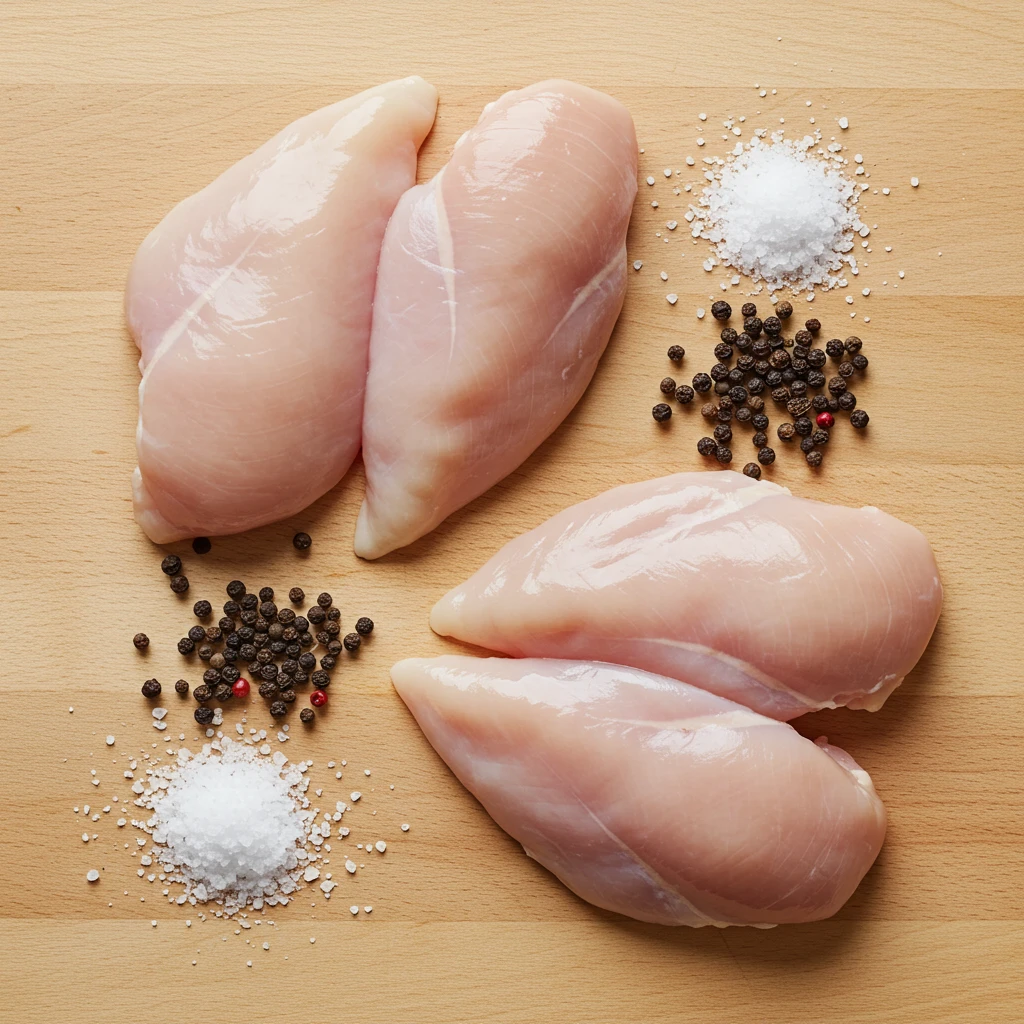
Full Ingredient List:
- 1.5 lbs Bone-in, Skin-on Chicken Thighs (about 4-6 thighs) – Opt for bone-in, skin-on for maximum flavor and juiciness.
- 2 tablespoons Beef Tallow or Lard – For cooking and adding rich, carnivore-friendly flavor.
- 2 teaspoons Sea Salt – Enhances the natural taste of the chicken and is crucial for seasoning.
- 1 teaspoon Black Pepper, freshly ground (optional, for those who include pepper in their carnivore diet) – Adds a touch of spice and depth (omit for strict carnivore).
Smart Ingredient Swaps and Easy Substitutions:
- Chicken Cut: Don’t have thighs? You can easily substitute with chicken drumsticks, wings, or even a whole chicken cut into pieces. Adjust cooking time accordingly – breasts will cook faster, while bone-in pieces may require slightly longer. For a leaner option, though less traditional in carnivore, skinless, boneless chicken thighs can be used, but be sure to monitor cooking time to prevent dryness and consider adding extra fat for cooking.
- Cooking Fat: Beef tallow or lard are excellent for carnivore cooking due to their flavor and health benefits. However, if you don’t have these on hand, butter or ghee (clarified butter) are great alternatives. For a different flavor profile, consider using duck fat or chicken fat (schmaltz), if available.
- Seasoning: While salt and pepper are classic, feel free to experiment with other carnivore-approved seasonings if you tolerate them. Consider adding a pinch of garlic powder (if tolerated) or onion powder (if tolerated) for a different flavor dimension. For a richer flavor, you can also use a homemade bone broth powder as part of your seasoning.
Budget-Friendly Tips and Finding Ingredients:
- Buy Chicken in Bulk: Purchasing chicken in larger quantities, especially bone-in, skin-on pieces, is often more economical. Check for sales at your local grocery store or butcher shop and freeze any excess portions for later use.
- Utilize Chicken Thighs: Chicken thighs are generally more affordable than chicken breasts and are naturally more flavorful and forgiving to cook, making them an excellent choice for budget-conscious carnivores.
- Render Your Own Tallow or Lard: Rendering your own animal fats is a cost-effective way to obtain high-quality cooking fat. You can often get beef fat trimmings from butchers at a reduced price or even free, and pork fatback is also relatively inexpensive. Rendering at home is simple and provides a pure, delicious cooking fat.
- Check Ethnic Markets: For spices and even meat, ethnic markets can sometimes offer better prices and unique options. Look for high-quality salt, pepper, and even different cuts of chicken at competitive prices.
- Minimalist Seasoning: Remember, the carnivore diet emphasizes simplicity. Focusing on high-quality salt and pepper (if tolerated) allows the natural flavor of the chicken to shine, reducing the need for expensive or elaborate spice blends. This minimalist approach is both budget-friendly and aligns perfectly with the diet’s principles.
Let’s Get Cooking! How to Make This Carnivore Chicken Recipe Step-by-Step

Prepare the Chicken: Pat the 1.5 lbs of bone-in, skin-on chicken thighs dry with paper towels. This step is crucial for achieving crispy skin. Season generously on all sides with 2 teaspoons of sea salt and 1 teaspoon of black pepper (if using). Ensure even seasoning for maximum flavor penetration.
FAQ: Why pat the chicken dry? Patting the chicken dry removes excess moisture from the skin’s surface. This is essential because moisture is the enemy of crispy skin. Dry skin will brown and crisp up beautifully when it comes into contact with hot fat.
Heat the Cooking Fat: In a large skillet, preferably cast iron, melt 2 tablespoons of beef tallow or lard over medium-high heat. Allow the fat to get shimmering hot. You’ll know it’s ready when a drop of water flicked into the pan sizzles immediately.
Tip: Achieving the Right Heat: Getting the fat hot enough is key to searing the chicken properly. Medium-high heat ensures a good sear without burning the fat. If the fat starts to smoke excessively, reduce the heat slightly.
Sear the Chicken: Carefully place the chicken thighs skin-side down in the hot skillet, ensuring not to overcrowd the pan. Work in batches if necessary to maintain proper searing temperature. Sear for 5-7 minutes, or until the skin is deeply golden brown and crispy. Avoid moving the chicken around too much during this initial sear to allow for maximum crisping.
Important: Don’t overcrowd the pan! Overcrowding will lower the temperature of the pan, leading to steamed chicken instead of seared. Searing in batches ensures each piece gets that beautiful crispy skin.
Flip and Cook Through: Once the skin is crispy, flip the chicken thighs. Reduce the heat to medium-low, cover the skillet, and cook for another 15-20 minutes, or until the chicken is cooked through and the internal temperature reaches 165°F (74°C). Use a meat thermometer to ensure accuracy, inserting it into the thickest part of the thigh, avoiding the bone.
Safety First: Checking for Doneness: Always use a meat thermometer to ensure chicken is safely cooked. Visual cues like juices running clear when pierced are not always reliable indicators of doneness. 165°F (74°C) is the safe internal temperature for chicken to prevent foodborne illness.
Rest the Chicken: Remove the chicken from the skillet and place it on a plate or cutting board. Let it rest for 5-10 minutes before serving. Tent loosely with foil to keep warm. Resting allows the juices to redistribute throughout the meat, resulting in a more tender and flavorful chicken.
Why Resting is Essential: Resting is a crucial step often overlooked. During cooking, the muscle fibers contract and push juices to the center. Resting allows these fibers to relax and reabsorb the juices, leading to a significantly juicier and more tender final product.
Serve and Enjoy: Serve your delicious carnivore chicken recipe immediately. The crispy skin and juicy, flavorful meat are perfect on their own or alongside other carnivore-friendly sides (see serving suggestions below!).
Expert Chef’s Tips and Tricks for the Best Carnivore Chicken Recipe

Elevate your carnivore chicken recipe from good to absolutely phenomenal with these expert tips and tricks:
Flavor Boosting Secrets:
- Salt Brining (Optional but Recommended): For extra juicy and flavorful chicken, consider a simple salt brine. Dissolve ¼ cup of sea salt in 4 cups of cold water. Submerge the chicken thighs in the brine for 30 minutes to 2 hours in the refrigerator. Rinse thoroughly and pat dry before seasoning and cooking. Brining helps the chicken retain moisture during cooking and enhances its natural flavor.
- Quality Salt Matters: Use a good quality sea salt or kosher salt. Table salt can sometimes have a metallic taste. Sea salt and kosher salt have a cleaner flavor and larger crystals, which distribute more evenly and enhance the taste of the chicken beautifully.
- Don’t Skimp on the Fat: Using enough animal fat for cooking is crucial not only for flavor but also for achieving crispy skin. The fat acts as a conductor of heat, helping the skin crisp up evenly and rendering out excess fat from the chicken skin itself.
- Crispy Skin Hack: High Heat Finish: For ultra-crispy skin, once the chicken is cooked through, you can increase the heat back to medium-high for the last 1-2 minutes of cooking (skin-side up), without the lid. Watch carefully to prevent burning. This final burst of heat will crisp up the skin even further.
Make-Ahead & Batch Cooking Wisdom:
- Prep Ahead (Seasoning): You can season the chicken up to 24 hours in advance and store it in the refrigerator, uncovered (on a wire rack placed over a plate to allow for air circulation). This allows the salt to penetrate the meat more deeply, enhancing flavor and tenderness. Just ensure to pat it dry again before searing to remove any excess moisture pulled out by the salt.
- Batch Cooking for the Week: This carnivore chicken recipe is perfect for batch cooking. Cook a larger quantity of chicken on the weekend and store it in the refrigerator for quick and easy meals throughout the week. It reheats beautifully and is a convenient protein source for busy carnivores.
Technique Perfection Tips:
- Cast Iron Advantage: If you have a cast iron skillet, use it! Cast iron retains heat incredibly well, providing even cooking and excellent searing, which are both essential for this recipe. If you don’t have cast iron, a heavy-bottomed stainless steel skillet will also work well.
- Proper Searing Technique: Ensure the pan and fat are hot before adding the chicken. You should hear a vigorous sizzle when the chicken hits the pan. Avoid moving the chicken around during the initial sear to allow a proper crust to form.
- Resting is Non-Negotiable: We can’t stress this enough – resting the chicken is essential for juicy results. Don’t skip this step! It makes a significant difference in the final texture and flavor of the chicken.
Serving Suggestions: Perfect Pairings for Your Carnivore Chicken

While this carnivore chicken recipe is delicious and satisfying on its own, you might be looking for ways to create a complete and fulfilling carnivore meal. Here are some perfect pairings and serving suggestions:
- Rendered Animal Fats: Embrace the carnivore ethos and serve your chicken with a side of rendered beef tallow, lard, or even chicken schmaltz. These fats add extra calories and flavor, enhancing satiety. You can use the rendered fat from cooking the chicken itself and drizzle it over the chicken before serving.
- Bone Broth: A warm mug of homemade bone broth is an excellent accompaniment. Bone broth is packed with nutrients, collagen, and electrolytes, making it a nourishing and comforting addition to your meal. Sip it alongside your chicken or use it as a base for a simple sauce by deglazing the pan after cooking the chicken (if desired, though strict carnivores might avoid deglazing with liquids).
- Organ Meats (Optional): For those incorporating organ meats into their carnivore diet, consider pairing your chicken with a small portion of cooked liver, heart, or kidney. These nutrient-dense foods complement the muscle meat and provide a wider spectrum of vitamins and minerals.
- Eggs: Fried, scrambled, or hard-boiled eggs are a simple and versatile side dish. Eggs are another excellent source of protein and healthy fats, making them a natural fit for a carnivore meal.
- Carnivore “Sides” – Think Fat: In the carnivore diet, “sides” often revolve around healthy fats. Consider a small amount of butter or ghee served alongside your chicken, or even a few slices of cooked bacon or crispy pork belly for added fat and flavor.
- Simple Pan Juices: Don’t discard the flavorful juices left in the pan after cooking the chicken! These pan juices, rich with rendered fat and chicken flavor, can be drizzled over the chicken for extra deliciousness.
- Water or Mineral Water: For beverages, stick to water or mineral water to stay hydrated and aligned with the carnivore diet principles.
How to Store and Reheat Your Delicious Carnivore Chicken
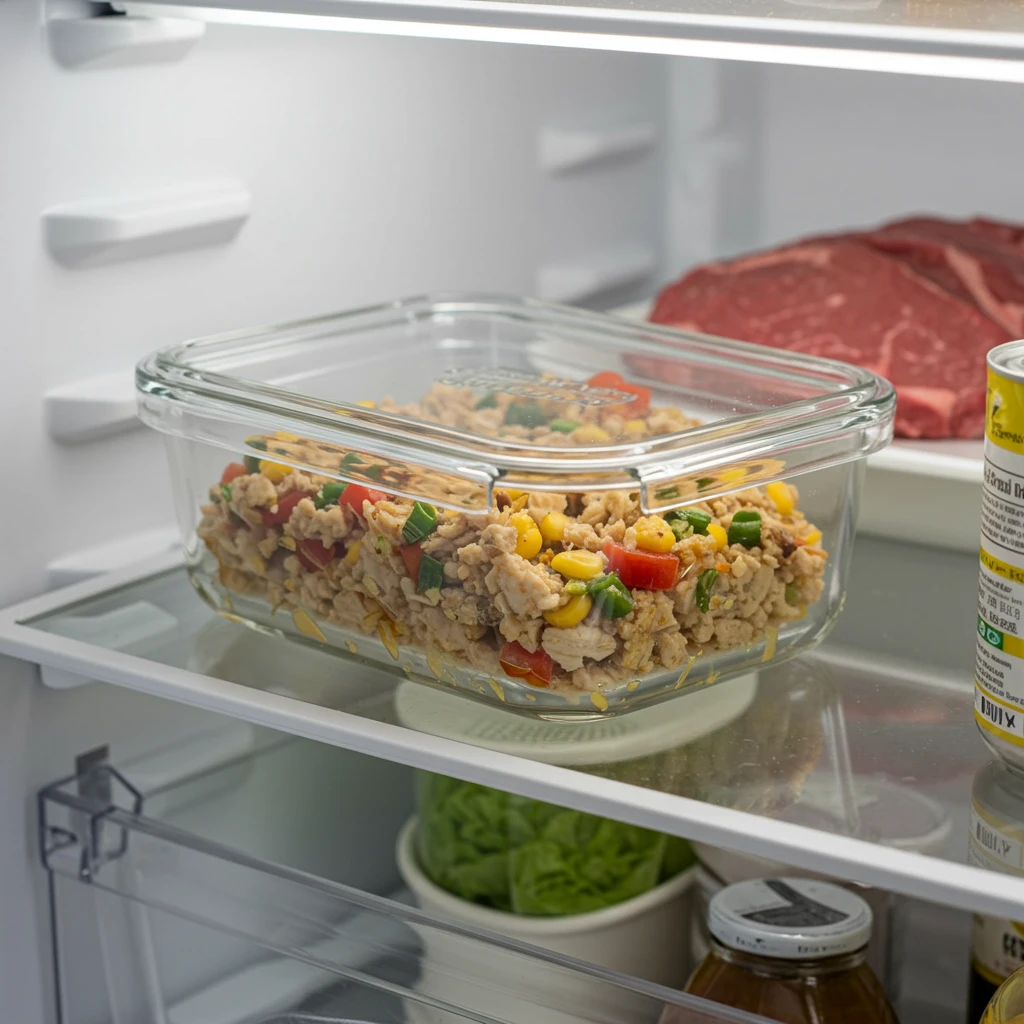
Enjoyed your carnivore chicken recipe but have leftovers? Here’s how to store and reheat it to maintain its deliciousness and safety:
Storing Leftover Carnivore Chicken:
- Cool Completely: Allow the cooked chicken to cool down to room temperature before storing. This prevents condensation from forming in the container, which can affect the texture and promote bacterial growth.
- Airtight Containers: Transfer the leftover chicken to airtight containers. Individual portions are great for easy grab-and-go meals.
- Refrigerate Promptly: Store the chicken in the refrigerator within 2 hours of cooking. Keep it at a temperature of 40°F (4°C) or below.
- Storage Duration: Properly stored cooked chicken is safe to eat for 3-4 days in the refrigerator. For longer storage, freezing is recommended (see below).
Reheating Your Carnivore Chicken:
- Oven Reheating (Best for Crispy Skin): Preheat your oven to 350°F (175°C). Place the chicken on a baking sheet and reheat for 15-20 minutes, or until heated through and the internal temperature reaches 165°F (74°C). This method helps to crisp up the skin again, though it might not be quite as crispy as freshly cooked.
- Skillet Reheating (Good for Moisture): Reheat in a skillet over medium-low heat with a little bit of added animal fat (tallow, lard, butter, etc.) to prevent drying out. Cover the skillet and heat for 5-10 minutes per side, or until heated through. This method helps retain moisture but the skin might soften slightly.
- Microwave Reheating (Quick but Can Dry Out): Microwave reheating is the quickest option, but it can sometimes dry out the chicken and make the skin soggy. Place the chicken on a microwave-safe plate and reheat in short intervals (1-2 minutes at a time), checking for doneness and moisture level. To minimize drying, you can place a damp paper towel over the chicken while microwaving.
- Freezing for Longer Storage: For longer storage, you can freeze cooked chicken. Wrap individual pieces tightly in plastic wrap, then place them in a freezer-safe bag or container. Frozen cooked chicken is best used within 2-3 months for optimal quality. Thaw overnight in the refrigerator before reheating using any of the methods above.
- Always Reheat to 165°F (74°C): Regardless of the reheating method, always ensure the internal temperature of the reheated chicken reaches 165°F (74°C) to ensure food safety. Use a meat thermometer to check.
Frequently Asked Questions About Making This Carnivore Chicken Recipe
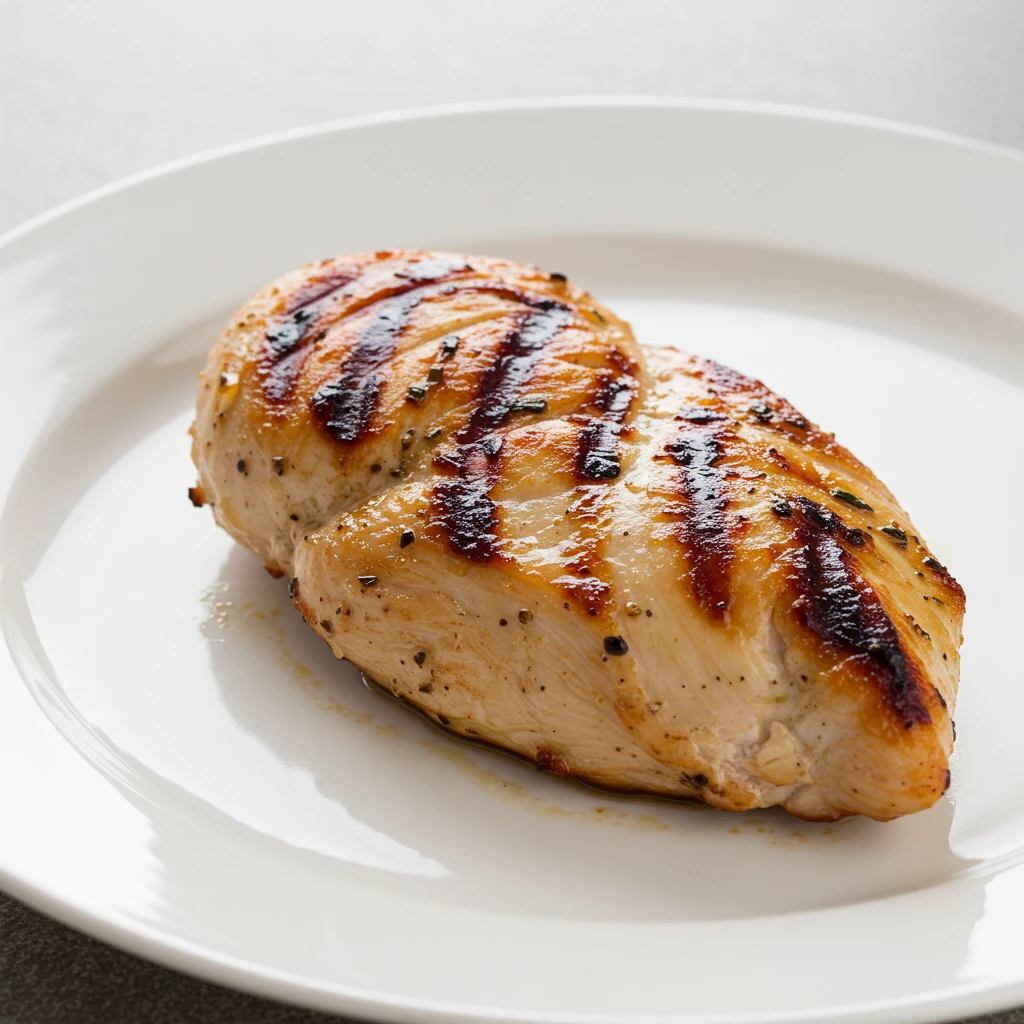
- What type of chicken is best for this recipe?
- Bone-in, skin-on chicken thighs are highly recommended for this recipe. They are more flavorful, juicier, and more forgiving to cook than chicken breasts, especially on the carnivore diet where fat content is desired. However, you can use other cuts like drumsticks, wings, or a whole chicken cut into pieces. Adjust cooking times accordingly.
- Can I use different seasonings besides salt and pepper?
- Yes, while salt and pepper are classic and align with a minimalist carnivore approach, you can experiment with other carnivore-friendly seasonings if you tolerate them. Consider garlic powder, onion powder, or bone broth powder for added flavor. Always check ingredient lists to ensure they are carnivore-compliant if you are following a strict carnivore diet.
- How do I know when the chicken is cooked through?
- The most reliable way to check for doneness is to use a meat thermometer. Insert it into the thickest part of the thigh, avoiding the bone. The internal temperature should reach 165°F (74°C). Juices running clear when pierced is not a reliable indicator on its own.
- Can I make this recipe ahead of time?
- You can season the chicken up to 24 hours in advance for enhanced flavor. Cooked chicken is also great for meal prep and can be stored in the refrigerator for 3-4 days or frozen for longer storage. Reheat as instructed above when ready to eat.
- What if I don’t have beef tallow or lard? Can I use other fats?
- Yes, you can substitute with other animal fats like butter, ghee, duck fat, or chicken schmaltz. The flavor profile will vary slightly depending on the fat used, but all are excellent carnivore-friendly options.
- My chicken skin isn’t crispy enough. What did I do wrong?
- Crispy skin requires dry chicken and hot fat. Ensure you pat the chicken completely dry before seasoning and searing. Make sure your cooking fat is hot enough before adding the chicken. Avoid overcrowding the pan, as this lowers the temperature. Searing skin-side down initially and finishing with a brief period of higher heat can also help crisp up the skin.
Enjoy Your Homemade Carnivore Chicken!

Congratulations, you’ve just mastered a truly delicious and satisfying carnivore chicken recipe! Simple, flavorful, and packed with goodness, this dish is sure to become a staple in your carnivore kitchen.
Did you love this recipe? Give it a ⭐️⭐️⭐️⭐️⭐️ rating below!
Share your culinary creations with us! Tag us on Instagram @finger_licking_recipes and Pinterest @FingerLicking_Recipes.
What are your favorite ways to enjoy carnivore chicken? Let us know in the comments below!
